Paston, Norfolk
| Paston | |
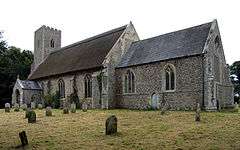 The Parish Church of Saint Margaret. |
|
 Paston |
|
| Area | 5.66 km2 (2.19 sq mi) |
|---|---|
| Population | 239 (parish, 2011 census)[1] |
| – density | 42/km2 (110/sq mi) |
| OS grid reference | TG275387 |
| – London | 139 miles (224 km) |
| Civil parish | Paston |
| District | North Norfolk |
| Shire county | Norfolk |
| Region | East |
| Country | England |
| Sovereign state | United Kingdom |
| Post town | NORTH WALSHAM |
| Postcode district | NR28 |
| Police | Norfolk |
| Fire | Norfolk |
| Ambulance | East of England |
| EU Parliament | East of England |
| UK Parliament | North Norfolk |
Coordinates: 52°51′28″N 1°26′59″E / 52.85781°N 01.44985°E
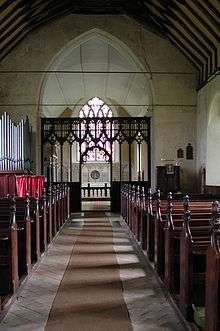
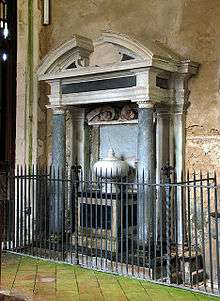
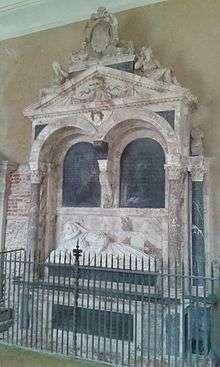
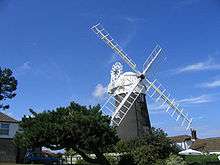
Paston is a village and civil parish in the English county of Norfolk.[2] The village is 4 miles (6.4 km) north-east of North Walsham and 9.1 miles (14.6 km) south-east of Cromer. It is 19.2 miles (30.9 km) north-east of the city of Norwich. The village sits astride the coast road between Mundesley and Bacton. The nearest railway station is at North Walsham for the Bittern Line which runs between Sheringham, Cromer and Norwich. The nearest airport is Norwich International.
The village gives its name to the Pastonian Stage, a British regional subdivision of the Pleistocene Epoch.
History
Paston is mentioned in the Domesday Book of 1086.[3] In the survey Paston is known by the name ‘Pastuna’ with the main tenant landowner being William de Warenne. It also mentions the church and a mill in the parish. From about 1400, the village was dominated by a family called Paston. Clement Paston was a small landowner who saved enough money to have his son, William (1378–1444), educated as a lawyer and ultimately become a judge. The family went on to acquire lands throughout the county and became notably wealthy. Indeed, there is an old saying in Norfolk that 'There was never a Paston poor, a Heydon a coward or a Cornwallis a fool.'[4] The family are remembered today mostly for their remarkable collection of private and business letters (the Paston Letters) that remain from the fifteenth century.[5] In 1597 Sir William Paston (1528–1610) moved the main family residence to Oxnead.[6] The last Paston of the male line, the 2nd Earl of Yarmouth, died in 1732.[7] The Paston estate was then acquired by Lord Anson, passing in the early nineteenth century to the Mack family.[8] The village was served by Paston & Knapton railway station on the North Walsham to Cromer section of the Norfolk and Suffolk Joint Railway from 1881 until 1964.
The parish church of Saint Margaret
The church dates from the 14th century and is constructed from flint.[9] English Heritage has given it Grade I listed building status.[10] It has an embattled tower which looks down on a thatched roof. The porch is on the south elevation and opens to a plain nave and chancel which is divided by an originally 15th century rood screen.[11] The church was restored in 1601, 1843 and again in 1869.[12] In 1922 wall paintings were uncovered. One is of Saint Christopher carrying the Christ child. Another depicts the legend of the three kings who, when hunting merrily in the forest, suddenly encountered three hanging skeletons.[13] There is also a small figure from a 'Weighing of souls' and the remains of some post-Reformation texts.[14]
The Paston Monuments are at the eastern end of the building. The tomb of Katherine Knevet (the wife of Sir Edmund Paston) who died in 1628 stands on the north side of the chancel. This was created by Nicholas Stone, the master-mason to King Charles I, who was frequently employed by the Paston family,[15] and contains a verse epitaph written by the famous 'metaphysical' poet John Donne who was Dean of St Paul's Cathedral, London.[16] The tomb is made of alabaster and pink-veined marble and shows a semi-reclining Lady Katherine, sculpted in white marble, surrounded by numerous allegorical figures. Stone also composed the neighbouring tomb of Sir Edmund who died in 1632. This has a plain urn on a bare base in an aedicule of black Doric columns. Pevsner comments that the 'contrast between the severity of the one and the ebullience of the other is startling'.[17] The chancel also contains three tomb-chests. The one at the eastern end is believed to be that of John Paston, who died in 1466 and was originally buried in Bromholm Priory in a magnificent funeral involving forty barrels of beer and ale.[14]
There are some stained glass windows that are in memory of members of the Mack family alongside memorial plaques within the nave. The east window is in memory of John Mack of Paston Hall, who died in 1867, and is attributed to the firm of Clayton and Bell. The south window next to the rood loft doorway is dedicated to Lt Cdr Ralph Michael Mack RN who went down with his ship, HMS Tornado, off the Dutch coast in 1917.[18]
The Paston Family
.jpg)
The village is probably best known for its association with the Paston family, who made their home in an earlier building on the site of the present Paston Hall. The family is most noted for the Paston Letters, a collection of letters and papers, consisting of the correspondence of members of the family, and others connected with them, between 1422 and 1509, and including some state papers and other important documents. Most of the Paston letters and associated documents are now in the British Museum, but a few are in the Bodleian Library, Oxford, at Magdalen College, Oxford, and at Pembroke College, Cambridge.[19]
In a letter dated 4 February 1445, Agnes Paston, the widow of William Paston, advised her son Edmond (1425–49) 'to think once of the day of your father's advice to learn the law; for he said many times that whosoever should dwell at Paston should have need to con defend himself'.[20] The letter goes on to list several disputes with neighbours. One of these was with the vicar of Paston over William's diversion of a highway from the south to the north side of the Paston family house and therefore of the church. This perhaps helps to explain why today the lychgate at Paston stands on a small path to Paston Hall rather than on the road to the north.[21] The dispute rumbled on for some years and about 1451 Agnes wrote to another son, John (1421–66) to tell him how an argument broke out on the subject after evensong on the Sunday before St Edmund's Day (i.e. in mid November). She was in the church when one Clement Spicer came up to her and demanded to know why she had closed the King's way. A Warren Harman, who had been leaning over the parclose and listening, then intervened, condemning the 'ruely change' and saying the 'town' was £100 worse off as a result. Agnes told him to mind his own business but he followed her out into the churchyard and said that he would have 20 nobles off her for closing the road and would open it again. Agnes warned that he would have to pay for his actions if he did. The row then moved on to whether Agnes had taken too much hay from land she rented to Harman at North Walsham. Bidding her to take no more than four acres, he strode off.[22]
Life in Paston at this time was dangerous because of raids from the sea by French sailors. Agnes, in another letter to John dated 11 March 1450 and written in Norwich, reports that Richard Lynsted had been to see her from Paston that day and had let her know that Warren Harman's half-brother had been 'taken with enemies' while walking along the sea side. Two pilgrims, a man and a woman, had also been attacked. The woman was robbed but allowed to go. The man was led down to the sea but when he managed to convince the raiders that he was indeed a pilgrim, they gave him money and put him back on land. Agnes also mentions that the pirates 'have thys weke takyn iiij vessellys of Wyntyrton and Happysborough, and Ecles men been sore aferd for takyn of mo, for there ben x grete vessellys of the enemyis' (the numerals are Roman, signifying four and ten ships).[23]
Paston Hall
The original Paston Hall was built by William Paston (1378–1444) in the fifteenth century. This building was partly destroyed by fire during the reign of King Henry VIII and was replaced by a 'great rose-coloured mansion' that appears in a portrait of Sir William Paston (1528–1610). According to Blomefield's History of Norfolk, published between 1739 and 1775, this Hall had two courts with the inner one containing a well. Blomefield reported that the great hall was still standing but the chambers and chapel were in ruins. The arms of the Berry family could be seen carved over a door, recalling the marriage of William Paston to Agnes Berry in 1420.[24]
In the eighteenth century, Lord Anson, who acquired the estate from the impecunious William Paston, 2nd Earl of Yarmouth, built a new house on the site. The remnants of the old house were left standing. An account written in 1796 says that the ruins stood at the east side of the courtyard with new domestic rooms on the north and south sides and a turreted gateway on the west. The gateway was described as being built of flint with quoins of freestone, with extensive cellars. A print of 1823 shows several polygonal chambers and excavations carried out in 1900 revealed the foundations of a hexagonal chamber. In 1824, John Mack acquired the estate and built the present Hall, incorporating parts of the Anson house and the Tudor cellars.[8]
At various times, Paston Hall has been surrounded by outhouses, shrubberies, orchards and lawns. To the south east is a small field known as the 'Duffus', which was the site of a medieval dovecote reached by a path along a double hawthorn hedge.[25]
Paston Great Tithe Barn
The tithe barn was built by Sir William Paston (1528–1610), the founder of the Paston Grammar School in North Walsham, in 1581 and was used to store and thresh corn. The barn is constructed of flint and brick with an alternate tie and hammerbeam roof, which is thatched. The barn is 160 feet (49 m) long and 24 feet (7.3 m) wide; to the apex the height is 60 feet (18 m). It has Grade II* listed building status.[26] Pevsner remarks that the roof span does not require hammer beams and that 'they are here for show: the Renaissance magnate's love of bravado and expression of wealth'.[17]
Stow Mill
Just on the Paston side of the boundary with Mundesley stands Stow Mill. This is a tarred brick tower windmill built between 1825 and 1827 by James Gaze. The mill operated as a flour mill between 1828 and 1930 and is now restored and open to visitors.[27] The mill is a Grade II listed building.[28]
See also
- Paston Letters
- Paston Great Barn
- Robert Paston, 1st Earl of Yarmouth
- William Paston, 2nd Earl of Yarmouth
- Paston & Knapton railway station
- Bromholm Priory
- Bacton Gas Terminal
- Oxnead
References
- ↑ "Civil Parish population 2011". Neighbourhood Statistics. Office for National Statistics. Retrieved 10 August 2016.
- ↑ "OS Explorer Map" 25, Norfolk Coast East, ISBN 0-319-21727-2
- ↑ The Domesday Book, Englands Heritage, Then and Now, Editor: Thomas Hinde,Norfolk page 192 ISBN 1-85833-440-3
- ↑ http://www.bbc.co.uk/history/british/middle_ages/pastonletters_01.shtml, accessed 30 June 2009
- ↑ Davis (1983), pp xiii–xxviii
- ↑ Oxford Dictionary of National Biography, Sir William Paston (1528–1610); www.oxforddnb.com; accessed 30 June 209
- ↑ Oxford Dictionary of National Biography, William Paston (1653/4-1732), 2nd Earl of Yarmouth; www.oxforddnb.com; accessed 30 June 2009
- 1 2 Yaxley (1977), p 102
- ↑ The King's England, Norfolk, by Arthur Mee, Page 250 ISBN 0-340-15061-0
- ↑ Historic England. "Details from image database (224293)". Images of England. Retrieved 14 June 2009.
- ↑ Lorraine (undated), p 4
- ↑ Lorraine (undated), p 3
- ↑ Lorraine (undated), pp 7–9
- 1 2 Pevsner and Wilson (1997), p 637
- ↑ Pevsner and Wilson (1997), p 637; Ketton-Cremer (1969), pp 42–49
- ↑ Lorraine (undated), pp 5–6
- 1 2 Pevsner and Wilson (1997), p 638
- ↑ Lorraine (undated), p 10; Pevsner and Wilson (1997), p637
- ↑ Davis (1983), pp xiii–xv, p xxvi; Colin Richmond, 'Paston family (per. c.1420–1504)', Oxford Dictionary of National Biography, Oxford University Press, Sept 2004; online edn, October 2006 accessed 5 July 2009
- ↑ Davis (1983), p 8; the language in this edition is modernised; Edmond was in fact studying law in London
- ↑ Yaxley (1977) p 99 says that the old road is now the Bacton drive – currently overgrown – to the present Hall.
- ↑ Davis (1983), pp 31–32; Bennett (1932) p 2 says that leave to divert the road is given in the Calendar of Patent Rolls of Henry VI [1441–46] p 192
- ↑ Davis (1971), letter 20; the pilgrims may have been visiting Bromholm Priory in Bacton, which claimed to have a true piece of the Holy Cross
- ↑ Yaxley(1977), p 101
- ↑ Yaxley (1977), pp 102
- ↑ Historic England. "Details from image database (224294)". Images of England. Retrieved 14 June 2009.
- ↑ http://www.stowmill.co.uk/index.html, accessed 14 June 2009
- ↑ Historic England. "Details from image database (224298)". Images of England. Retrieved 14 June 2009.
Bibliography
- Bennett, Henry S (1932) The Pastons and their England: Studies in an Age of Transition, Cambridge, Cambridge University Press (2nd edition)
- Davis, Norman (1971) Paston Letters and Papers of the Fifteenth Century – Part I, Oxford, The Clarendon Press ISBN 0-19-812415-5
- Davis, Norman (1983) The Paston Letters, Oxford, The World's Classics: Oxford University Press ISBN 0-19-281615-2
- Hinde, Thomas (ed.) (1996) The Domesday Book: England's Heritage Then and Now, London, Colour Library Direct Ltd ISBN 1-85833-440-3
- Hughey, Ruth (ed.) (1941) 'The Correspondence of Lady Katherine Paston 1603–1627', Norfolk Record Society, xiv 1941
- Ketton-Cremer, R W (1969) Norfolk in the Civil War, London, Faber and Faber
- Lorraine, Herbert (undated), Paston: Some Notes on the Church of St Margaret and the Paston Family; this version published by Paston Parochial Church Council; originally published in 1949 at North Walsham by Rounce and Wortley
- Mee, Arthur (1974) Norfolk (King's England), London, Hodder and Stoughton ISBN 0-340-15061-0
- Pevsner, Nikolaus and Wilson, Bill (1997) The Buildings of England: Norfolk 1: Norwich and the North-East, London, Penguin Books ISBN 0-14-071058-2
- Yaxley, David (1977) Portrait of Norfolk, Norwich, Robert Hale Ltd ISBN 0-7091-6267-7
External links
| Wikimedia Commons has media related to Paston, Norfolk. |
- Home page of the Paston Heritage Society
- Historical information on Paston at GENUKI Norfolk
- Paston in a Vision of Britain through Time
- Information on Stow Mill, Paston
- Literary Norfolk page on Paston